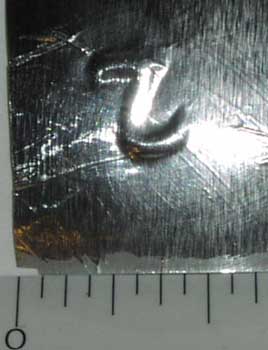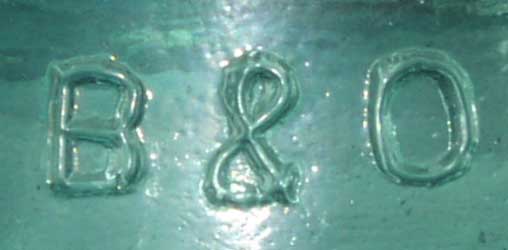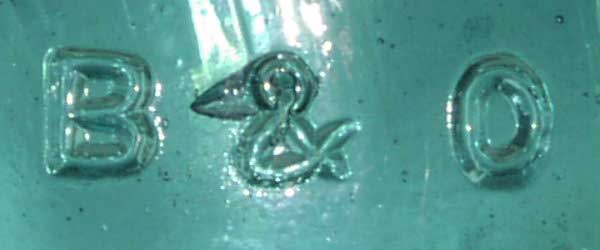[ Home | What's New | Articles ]
Outline
1. Beginning Interest
2. Why Texas?
3. Manufacturing timeframe
4. The shop number importance
5. Mold differences
6. Colors
7. Conclusions and request for additional information
I first became interested in the CD 136 style while assisting in the research effort of my good friend Lee Brewer on the crown embossed Brookfield (CREB) CD 145 beehives. The CREB 145s are still my favorite as they have a crude, yet classic beehive shape, numerous shop number embossing variations, and like most Brookfield pieces a variety of embossing errors and glass impurities. The CD 136 shape intrigued me as I considered it similar to the beehive only with “fat lip” wire groove edges. I was further hooked when I discovered that these too were embossed with shop numbers. The final connection for me was that many of these had been and could still be found in my resident state Texas.
Recognizing that the CREB 136s have “B&O” embossed on the skirt, I was curious as to how these pieces ended up in Texas. The B&O (Baltimore and Ohio Railroad) was a very early carrier dating back to the late 1820s. My research into their operation told me that their lines operated only as far west as St. Louis, MO. I began contacting B&O experts, the B&O Historical Society, and several Texas railroading enthusiast web sites to try to determine the link between the B&O and Texas.
I learned through this research that while the B&O did not construct lines into Texas, the Texas and Pacific Railway (T&P) did construct lines from St. Louis into Texas with the intention of completing a southern transcontinental route to San Diego, CA. My initial assumption was that some deal was struck between B&O and the T&P to allow the CREB136 B&O insulators to be used along the telegraph lines accompanying the T&P railways. Although this theory seems plausible, additional information was obtained to support another hypothesis.
Discussions with N. R. Woodward and R. Klingensmith suggested that CD 136 B&O insulators made their way into Texas via the B&O Telegraph Co., a subsidiary of the B&O Railroad Company. I began to explore this option via the same resources I had consulted earlier. Tom Greco from the B&O historical society was able to send me a telegram with letterhead confirming that B&O Telegraph Co. had offices in Texas. I now believe that this theory is the most probable explanation for the presence of CD 136 B&O insulators in Texas. If anyone has any information confirming or denying this claim, I would certainly appreciate the opportunity to explore this further.

The approximate timeframe for manufacture of the Brookfield CD 136 is from the late1870s through the mid 1880s. The CD 145 became the Brookfield standard for telegraph/telephone service following the Samuel Oakman patents for double petticoat and beehive style insulators (November 13, 1883 and February 12, 1884 respectively). Apparently Brookfield patterned the CD 136 after either the Canadian CD 136.4 or the Boston Bottle Works CD 136.5. The earliest Brookfield CD 136 is taller than the CREB successor and did not contain Brookfield embossing. Speculation would suggest that the reason for avoiding embossing the Brookfield name on this earlier version was to avoid potential lawsuits.

From discussions with Brookfield and Hemingray experts, the consensus is that the Brookfield pieces were produced prior to the Hemingray CD 136. The Hemingray version is believed to be the last CD 136 manufactured.
Shop numbers can be found on many CD styles of Brookfield insulators. N. R. Woodward, creator of the CD numbering system, explains in his book “The Glass Insulator in America: 1988 report” that the numbers and letters on the front or rear crowns of many Brookfield insulators refer to the shop of 4 workers that produced them. The employees at the glassworks were paid based on the number of pieces produced in a given unit of time. This payment method was achieved by counting, or weighing, the insulators with a given shop number after they emerged from the cooling end of the lehr. This same concept is believed to be the reason for mold letters on the HGCO Petticoat CD 145 beehives.
The CREB CD 136 B&O insulators have been found with shop numbers 1 through 6 as can be seen in the attached foil rubbings of these numbers. Shop numbers 4, 5, and 6 have been found in two different sizes as can be seen in the foil rubbing comparison photos (see foil rubbing photos). In addition to the size difference, the shop number 5 pieces have either a straight top or a curved top. As with the CREB 145s, certain shop numbers are more difficult to acquire than others. My experience is that pieces with the shop number 3 (backwards) appear to be the least common.






The best tool I’ve come across to compare insulator mold differences is the “Meier Mask”. This method devised by ICON webmaster Bill Meier consists of using clear cellophane tape and Sharpie permanent markers to trace out the embossing on a given insulator. This “mask” can then be placed against other insulators to determine if they are from the same mold. Lee Brewer has modified this original method slightly by using clear acetate instead of cellophane tape to make his masks. These masks have been the cornerstone of his research effort on the CREB145s for comparing mold similarities/differences.
In incorporating this technique into the research of CREB CD 136s, I’ve discovered that 10 different molds have been found within the 9 shop number variations. One of the most prominent differences in molds can be found in the spacing and style of the “B&O” embossing on the skirt. Some of these differences are seen in the attached photos; however, most are subtle and are only apparent when using masks for mold comparisons.
The shop numbers 1 through 3 that I have seen have all been [040] style, that is both the front and rear crowns have the backwards “N”. Shop numbers 4 through 6 have all been [060] with no backward “N” embossings. I have not seen styles [010], [020], [030], and [050] that are listed in the price guide. If anyone has a representative of one of these styles, please contact me.
The following information about each shop number provides the details of the mold differences mentioned earlier:




If you’re collecting CREB CD 136s for their colors, you’re liable to be disappointed. The vast majority of these pieces are found in either light blue or aqua. These blue and aqua pieces can have added character, however, with the inclusion of either amber or milk swirls. I have personally seen or own the greens, apple greens, lime greens, and light greens that are listed in the price guide. I know of only one yellow olive green piece; however, I’ve not had the pleasure of seeing it in person. Reference photos of lime green, light green, and apple green pieces and other color comparison photos.


The information contained in this article results from a detailed analysis of 30+ pieces and observations on over 100+ pieces. Recognizing that this sample lot is small in comparison to the number of insulators manufactured, dissenting information is not only expected but extremely welcomed.
Reprinted from Crown Jewels Of the Wide; used with permission
![]() Return to the Research Articles
page
Return to the Research Articles
page
If you have questions or comments, please use this Feedback Form.
Last updated Tuesday, November 30, 2004